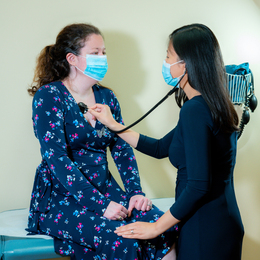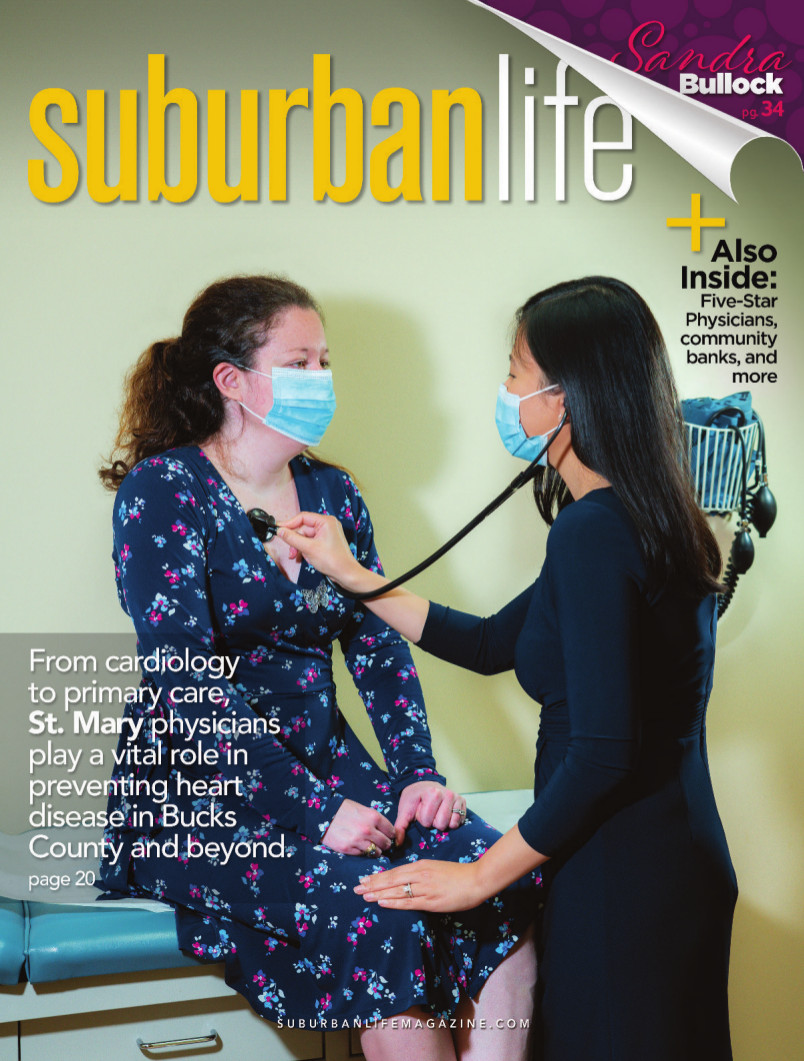
Close to Heart
From cardiology to primary care, St. Mary physicians play a vital role in preventing heart disease in Bucks County and beyond.
When it comes to cardiovascular health, Toni Anne De Venecia, M.D., does not mince words.
“Prevention is key,” says Dr. De Venecia, a cardiologist with St. Mary Comprehensive Cardiology at St. Mary Medical Center in Langhorne. “People need to know and ask what their risks are. With heart disease, prevention is definitely better than cure.”
Dr. De Venecia and the cardiac team at St. Mary Medical Center stand on the front lines of the war against heart disease, which is the leading cause of death among American men and women. Approximately 659,000 people in the United States die from heart disease each year—about one in every four deaths, according to the U.S. Centers for Disease Control and Prevention.
St. Mary Medical Center is a regionally recognized center in the treatment of common types of cardiovascular disease, including coronary heart disease, stroke, hypertension, and congestive heart failure. St. Mary physicians specialize in preventative cardiac health, as well as interventions such as cardiac catheterization and bypass surgery. St. Mary is one of the high-volume centers for cardiovascular procedures performed in Bucks County, according to Dr. De Venecia. She suggests those numbers would be lower if people engaged in exercise and other forms of physical activity more often.
“At each visit with a patient, I discuss with them about all the risks: cigarette smoking, sedentary lifestyle, diabetes, high blood pressure, high cholesterol, and calcium buildup in the arteries,” she adds. “They all affect the heart. Other factors such as race (Blacks and South Asians) are also linked with higher risk.”
Dr. De Venecia notes that calcium buildup in arteries can result in dire consequences. At St. Mary Medical Center, patients can undergo a computed tomography (CT) coronary calcium score. It’s a quick, convenient, and noninvasive imaging test to evaluate the amount of calcified plaque in the heart. The level of calcium equates to the plaque buildup in the arteries, which then correlates with the risk for heart attack.
“A patient may not have symptoms, but a CT calcium score helps us to risk stratify our patients’ risk for future heart attacks depending on the extent of calcium buildup in the arteries,” Dr. De Venecia says. “In turn, we are able to intensify education on lifestyle modification and initiate lipid-lowering medication to patients that are at highest risk.”
‘No Greater Gift’
Dr. De Venecia has a special interest in women’s cardiac health and prevention. Heart disease is the leading cause of death for women in America, according to the CDC, accounting for about one in every five female deaths.
Dr. De Venecia has a special interest in women’s cardiac health and prevention. Heart disease is the leading cause of death for women in America, according to the CDC, accounting for about one in every five female deaths.
“Cardiac problems in women are often underdiagnosed because they present differently than men,” she says. “Women with significant coronary artery disease can present with palpitations, shortness of breath, jaw pain, or epigastric pain. They don’t always get tightness in the chest with radiation down the left arm. Statistically, because of that, women are more often than not sent home from the hospital when they shouldn’t have been, and they don’t get the same medical attention as men.”
Many people have the impression that men suffer from heart disease more commonly than women. Women who present with atypical cardiac symptoms are often misdiagnosed, therefore contributing to a higher mortality rate in women due to cardiovascular disease. “Cardiovascular disease is the leading cause of death in women, and most of the cardiovascular diseases are preventable,” says Surbhi Bhargava, M.D., a primary care physician with St. Mary Health Feasterville. Some identifiable risk factors that are specific to women include premature menopause, gestational diabetes or hypertension during pregnancy, pre-term birth, and the use of oral contraception or hormone replacement therapy.
Regardless of gender or history, Drs. De Venecia and Bhargava offer the same advice to each patient: Know your risks, adopt a healthy lifestyle, and see your primary care physician regularly.
Dr. Bhargava recommends all adults, especially those over the age of 40, see a primary care physician at least once a year for bloodwork, an EKG, and other tools to evaluate their risk of developing heart disease. Since joining St. Mary in 2019, she has incorporated “the ABCDEs of Primary Prevention” into her practice. She refers to this straightforward framework of lifestyle changes and team-based care as “a good way to help patients prevent cardiovascular disease.”
“A is for assessing risk; it’s also for aspirin, which is to be taken in low doses for high-risk patients,” she adds. “B is for blood pressure and C is for cholesterol, both of which need to be monitored regularly; C is also for cigarette smoking, and we need to make sure people have the resources to quit. D is for diet and weight management, as people should be eating a diet rich with vegetables, fruits, nuts, and legumes; D also stands for diabetes, because it’s important to catch the disease while it’s still in the prediabetic stage. E is for exercise, with the recommendation being at least 30 minutes of moderate to vigorous exercise every day, or 150 minutes every week.”
Unexpected disruptions caused by the pandemic negatively affected people’s lifestyles—namely, making them more sedentary and upending their eating habits. To make matters worse, many people stayed away from the doctor’s office, thereby missing out on regular screenings, out of fear of contracting the virus.
St. Mary’s online patient portal has given patients a convenient tool for scheduling regular appointments and screenings. While the portal encourages patients to play an active role in their health, Dr. Bhargava says patients should know that some health concerns require more immediate care. Anyone who may be experiencing chest pain, for example, should forgo the portal and proceed directly to the ER for prompt evaluation.
Dr. Bhargava considers her work a calling rather than a vocation. By preventing patients from developing heart disease or helping patients with a history of heart disease reduce the risk of having future problems, she feels as though she is truly making a difference in the world.
“One of the reasons I chose to become a primary care physician is to be able to treat the individual as a whole, focusing on their personalized health goals and treatment plans,” she says. “I’ve always loved the idea of preventative care and continuity of care. There’s no greater gift we can give than helping people stay healthy.”
St. Mary Medical Center
1201 Langhorne-Newtown Road
Langhorne, PA 19047
(215) 710-2000
www.trinityhealthma.org/location/st-mary-medical-center
1201 Langhorne-Newtown Road
Langhorne, PA 19047
(215) 710-2000
www.trinityhealthma.org/location/st-mary-medical-center
Photograph by Jody Robinson
Published (and copyrighted) in Suburban Life magazine, May 2022.



